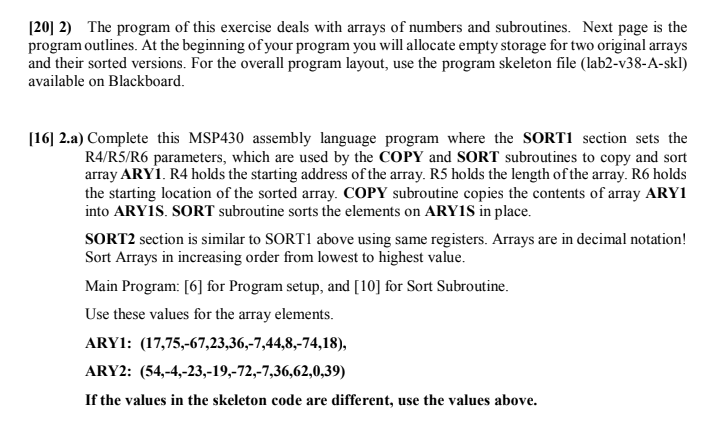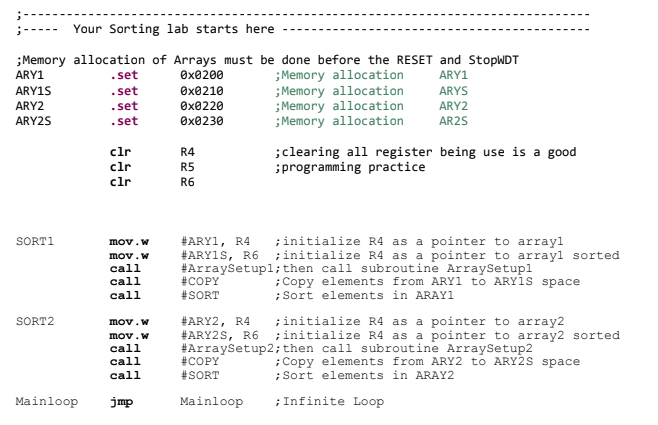Question
Microprocessors Systems MSP430G2553 Microprocessor Used **TYPE THE SOLUTION PLEASE** Write an assembly program, in CCS 7.4.0 THE SORTING LAB IS TYPED BELOW, FOR YOUR CONVIENIENCE:
Microprocessors Systems
MSP430G2553 Microprocessor Used
**TYPE THE SOLUTION PLEASE**
Write an assembly program, in CCS 7.4.0



THE SORTING LAB IS TYPED BELOW, FOR YOUR CONVIENIENCE:
;-------------------------------------------------------------------------------
; MSP430 Assembler Code Template for use with TI Code Composer Studio
;-------------------------------------------------------------------------------
.cdecls C,LIST,"msp430.h" ; Include device header file
.def RESET
.text ; Assemble into program memory
.retain ; Override ELF conditional linking and retain current section
.retainrefs ; Additionally retain any sections that have references to current section
;-------------------------------------------------------------------------------
RESET mov.w #__STACK_END,SP ; Initialize stackpointer
StopWDT mov.w #WDTPW|WDTHOLD,&WDTCTL ; Stop watchdog timer
;-------------------------------------------------------------------------------
;----- Your Sorting lab starts here -------------------------------------------
;Memory allocation of arrays must be done prior to the RESET & StopWDT
ARY1 .set 0x0200 ;Memory allocation ARY1
ARY1S .set 0x0210 ;Memory allocation ARYS
ARY2 .set 0x0220 ;Memory allocation ARY2
ARY2S .set 0x0230 ;Memory allocation AR2S
clr R4 ;Clear Register
clr R5 ;Clear Register
clr R6 ;Clear Register
SORT1 mov.w #ARY1, R4 ;Intialize R4 to poin to ARY1 in the memory
mov.w #ARY1S, R6 ;Intialize R6 to poin to ARY1S in the memory where the sorted ARY1 will be stored
call #ArraySetup1 ;Creat elements are store them in ARY1
call #COPY ;Copy the elements from the ARY1 space to ARY1S space
call #SORT ;Calling Subroutine Sort with parameter passing in R4 abd R6
SORT2 mov.w #ARY2, R4 ;Intialize R4 to poin to ARY2 in the memory
mov.w #ARY2S, R6 ;Intialize R6 to poin to ARY2S in the memory where the sorted ARY2 will be stored
call #ArraySetup2 ;Creat elements are store them in ARY2
call #COPY ;Copy the elements from the ARY2 space to ARY1S space
call #SORT ;Calling Subroutine Sort with parameter passing in R4 abd R6
Mainloop jmp Mainloop ;loop in place for ever
;Array element intitialization Subroutine
ArraySetup1 mov.b #10, 0(R4) ;Define the number of elements in the array
mov.b #20, 1(R4) ;store an element
mov.b #89, 2(R4) ;store an element
mov.b #-5, 3(R4) ;store an element
mov.b #13, 4(R4) ;store an element
mov.b #63, 5(R4) ;store an element
mov.b #-1, 6(R4) ;store an element
mov.b #-88, 7(R4) ;store an element
mov.b #2, 8(R4) ;store an element
mov.b #-88, 9(R4) ;store an element
mov.b #-1, 10(R4) ;store an element
ret
;Array element intitialization Subroutine
ArraySetup2 mov.b #10, 0(R4) ;Define the number of elements in the array
mov.b #90, 1(R4) ;store an element
mov.b #-10, 2(R4) ;store an element
mov.b #-45, 3(R4) ;store an element
mov.b #25, 4(R4) ;store an element
mov.b #-46, 5(R4) ;store an element
mov.b #-8, 6(R4) ;store an element
mov.b #99, 7(R4) ;store an element
mov.b #20, 8(R4) ;store an element
mov.b #0, 9(R4) ;store an element
mov.b #-64, 10(R4) ;store an element
ret
;Copy original Array to allocated Array-Sorted space
COPY mov.b 0(R4), R10 ;save n (number of elements) in R10
inc.b R10 ;increment by 1 to account for the byte n to be copied as well
mov.w R4, R5 ;copy R4 to R5 so we keep R4 unchanged for later use
mov.w R6, R7 ;copy R6 to R7 so we keep R6 unchanged for later use
LP mov.b @R5+, 0(R7) ;copy elements using R5/R7 as pointers
inc.w R7
dec R10
jnz LP
ret
;Sort the copy of Array saved in the allocated Array-Sorted space, while keeping original Array unchanged
;replace the following two lines with your actual sorting algorithm.
SORT nop
ret
;To bubble sort, you need to scan the array n-1 times,
;and in every scan you compare from top down each two consecutive elements,
;and you swap them if they if they are not in ascending order.
;Notice that in the first scan you get the largest element pushed all the way to the bottom,
;so your next scan should be n-1, and then n-2 and so on.
;So every time you come back to the top of the array for a new scan, your n (the number of comparisons) must be decremented by 1.
;In the last scan, you need only one comparison.
;Your sorting algorithm starts with R6 as a pointer to the array
;you need to save n (number of elements) in R8, then decrement it by 1 (n-1) to become the number of comparisons.
;Copy R6 to R7 so you keep R6 unchanged pointing to the top of the array for every new scan.
;Copy n-1 to R9 as a loop counter, while keeping n-1 in R8 for the next scan.
;In the scan loop get an element and auto increment pointer R7, then get next element without changing R7.
;Compare the two elements, if not in ascending order, swap them.
;Repeat the scan from the top (always R6), and every time decrement the number of comparisons (R8).
;----- Your Sorting lab ends here -------------------------------------------
;-------------------------------------------------------------------------------
;-------------------------------------------------------------------------------
;Stack Pointer definition
.global __STACK_END
.sect .stack
;-------------------------------------------------------------------------------
;Interrupt Vectors
.sect ".reset" ;MSP430 RESET Vector
.short RESET
[20] 2) The program of this exercise deals with arrays of numbers and subroutines. Next page is the program outlines. At the beginning of your program you will allocate empty storage for two original arrays and their sorted versions. For the overall program layout, use the program skeleton file (lab2-v38-A-skl) available on Blackboard 16] 2.a) Complete this MSP430 assembly language program where the SORTI section sets the R4/R5/R6 parameters, which are used by the COPY and SORT subroutines to copy and sort array ARY1. R4 holds the starting address of the array. R5 holds the length of the array. R6 holds the starting location of the sorted array. COPY subroutine copies the contents of array ARY1 into ARY1S. SORT subroutine sorts the elements on ARY1S in place. SORT2 section is similar to SORT1 above using same registers. Arrays are in decimal notation! Sort Arrays in increasing order from lowest to highest value Main Program: [6] for Program setup, and [10] for Sort Subroutine Use these values for the array elements. ARY1: (17,75.-67,23,36,-7,44,8.-74,18), ARY2: (54,-4,-23,-19,-72.-7,36,62,0,39) If the values in the skeleton code are different, use the values above [20] 2) The program of this exercise deals with arrays of numbers and subroutines. Next page is the program outlines. At the beginning of your program you will allocate empty storage for two original arrays and their sorted versions. For the overall program layout, use the program skeleton file (lab2-v38-A-skl) available on Blackboard 16] 2.a) Complete this MSP430 assembly language program where the SORTI section sets the R4/R5/R6 parameters, which are used by the COPY and SORT subroutines to copy and sort array ARY1. R4 holds the starting address of the array. R5 holds the length of the array. R6 holds the starting location of the sorted array. COPY subroutine copies the contents of array ARY1 into ARY1S. SORT subroutine sorts the elements on ARY1S in place. SORT2 section is similar to SORT1 above using same registers. Arrays are in decimal notation! Sort Arrays in increasing order from lowest to highest value Main Program: [6] for Program setup, and [10] for Sort Subroutine Use these values for the array elements. ARY1: (17,75.-67,23,36,-7,44,8.-74,18), ARY2: (54,-4,-23,-19,-72.-7,36,62,0,39) If the values in the skeleton code are different, use the values aboveStep by Step Solution
There are 3 Steps involved in it
Step: 1

Get Instant Access to Expert-Tailored Solutions
See step-by-step solutions with expert insights and AI powered tools for academic success
Step: 2

Step: 3

Ace Your Homework with AI
Get the answers you need in no time with our AI-driven, step-by-step assistance
Get Started


